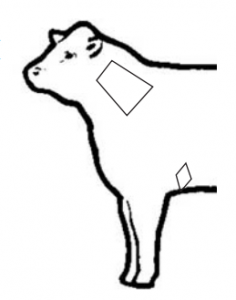Cattle owners vaccinating their cattle to prevent sickness is a prime example of “an ounce of prevention is worth a pound of cure.” This single management practice provides a huge step toward lowering the incidence of antibiotic use in the industry. Every sickness cannot be prevented all of the time; however, healthy beef cattle that are current on vaccinations provide a wholesome, healthy product in our food supply. This is an important component in maintaining consumer confidence in our American beef supply. Cattle vaccinations should be a priority tool for all people raising cattle.
What Vaccinations are important?
 Each cattle owner can potentially have different needs when it comes to creating a preventative herd health plan. Consultation with a veterinarian provides the expertise you need to be sure you have a comprehensive plan. In general, the vaccines of particular interest include blackleg, bovine rhinotracheitis (IBR), bovine viral diarrhea (BVD), bovine respiratory syncytial virus (BRSV), parainfluenza, clostridium perfringes, haemophilus, pasteurella, and leptospira. Many of these vaccines are joined into 5-way to 8-way combinations to reduce the number of injections needed. By preventing respiratory infections, the incidence of antibiotic use is greatly lessened.
Each cattle owner can potentially have different needs when it comes to creating a preventative herd health plan. Consultation with a veterinarian provides the expertise you need to be sure you have a comprehensive plan. In general, the vaccines of particular interest include blackleg, bovine rhinotracheitis (IBR), bovine viral diarrhea (BVD), bovine respiratory syncytial virus (BRSV), parainfluenza, clostridium perfringes, haemophilus, pasteurella, and leptospira. Many of these vaccines are joined into 5-way to 8-way combinations to reduce the number of injections needed. By preventing respiratory infections, the incidence of antibiotic use is greatly lessened.
What Method is Best?

“Method” could be interpreted as technique or protocol. Placement of injection (location on the animal) and how the injection is applied are very important. Always put injections in the “triangle” in the neck. This area is in better proximity to the lymph node system for rapid distribution in the animal. Also, the neck muscle is not a “prime” cut of beef and is processed in such a way that if there is any damage, it is easily identified and removed before entering the food supply. After reading the medication label, always choose subcutaneous (under the skin) for application of the vaccine if the option is available. Subcutaneous shots do not enter the muscle and keeps any possible injection site reactions away from muscle tissue.
What if you do need a Cure?
Sickness cannot always be prevented. If an animal does become sick, as good stewards for the welfare of an animal we may need to treat an illness with antibiotics. Consultation with a veterinarian to make a treatment plan will be best. Always follow label instructions for dosage and withdrawal times. Withdrawal times are established by the Food and Drug Administration to allow time for medications to exit the body or at least be well below a tolerance level.
Remember, prevention is much less expensive than a cure. Anyone who raises cattle has an obligation to practice a prevention program. If you do not, you only pass on problems to the next owner once you sell your cattle or calves. Following Best Management Practices laid out in the Beef Quality Assurance program helps all cattle producers provide a healthy, wholesome product for beef consumers. Remember, an ounce of prevention is DEFINITELY worth a pound of cure.
If you are interested in learning more about Vaccinations and Parasite Control in Beef Cattle, there will be a free seminar in Dade City at the Pasco Extension Office on May 17, at 6:30 pm.
Beef Quality Assurance Handbook
 0
0
